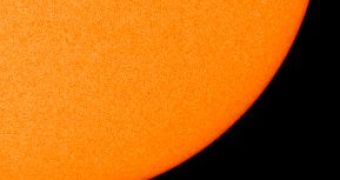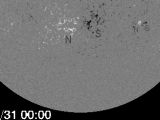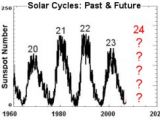On July 31st, a tiny sunspot was born. It popped up from the sun's interior, floated around a bit, and vanished again in a few hours. On the sun this sort of thing happens all the time and, ordinarily, it wouldn't be worth mentioning. But this sunspot was special: It was backward. "Backward" means magnetically backward (see picture below - SOHO magnetogram of the sun. July 31, 2006).
On the sun, there is a grand pattern of sunspot polarities. In the sun's northern hemisphere, all spots are S-N. In the southern hemisphere, all spots are N-S. This is how it has been for the past 10+ years during Solar Cycle 23. When Cycle 24 arrives, the grand pattern will flip. Northern sunspots will become N-S while southern sunspots will become S-N. This flipping action occurs every time one cycle gives way to another.
The July 31st sunspot, with its S-N orientation, would have fit right in, if it had popped up in the sun's northern hemisphere. All the spots around it would've been S-N, too. Instead, it emerged in the southern hemisphere where N-S has held sway for a decade. This made it backwards and a harbinger of the next solar cycle.
"We've been waiting for this," says David Hathaway, a solar physicist at the Marshall Space Flight in Huntsville, Alabama. "A backward sunspot is a sign that the next solar cycle is beginning."
In the magnetic map of the sun above, N is white and S is black. The backward sunspot is circled. This tiny spot of backwardness matters because of what it might foretell: A really big solar cycle.
Solar activity rises and falls in 11-year cycles, swinging back and forth between times of quiet and storminess. Right now, the sun is quiet. "We're near the end of Solar Cycle 23, which peaked way back in 2001," explains Hathaway. The next cycle, Solar Cycle 24, should begin "any time now," returning the sun to a stormy state.
Satellite operators and NASA mission planners are bracing for this next solar cycle because it is expected to be exceptionally stormy, perhaps the stormiest in decades. Sunspots and solar flares will return in abundance, producing bright auroras on Earth and dangerous proton storms in space.
But when will Solar Cycle 24 begin?
"Maybe it already did--on July 31st," says Hathaway. The first spot of a new solar cycle is always backwards. Solar physicists have long known that sunspot magnetic fields reverse polarity from cycle to cycle. N-S becomes S-N and vice versa. "The backward sunspot may be the first sunspot of Cycle 24."
It sounds exciting, but Hathaway is cautious on several fronts:
First, the sunspot lasted only three hours. Typically, sunspots last days, weeks or even months. Three hours is fleeting in the extreme. "It came and went so fast, it was not given an official sunspot number," says Hathaway. The astronomers who number sunspots didn't think it worthy!
Second, the latitude of the spot is suspicious. New-cycle sunspots almost always pop up at mid-latitudes, around 30N or 30S. The backward sunspot popped up at 13S. "That's strange."
These odd-isms stop Hathaway short of declaring the onset of a new solar cycle. "But it looks promising," he says.
Even if Cycle 24 has truly begun, "don't expect any great storms right away." Solar cycles last 11 years and take time to build up to fever pitch. For a while, perhaps one or two years, Cycle 23 and Cycle 24 will actually share the sun, making it a hodgepodge of backward and forward spots. Eventually, Cycle 24 will take over completely; then the fireworks will really begin.
Meanwhile, Hathaway plans to keep an eye out for more backward sunspots.

 14 DAY TRIAL //
14 DAY TRIAL // 

